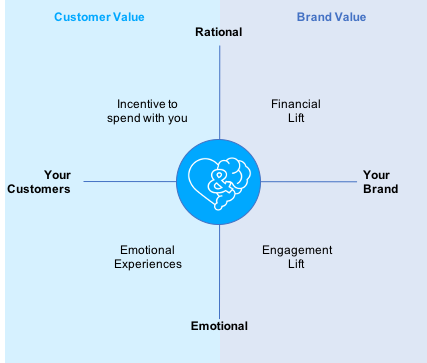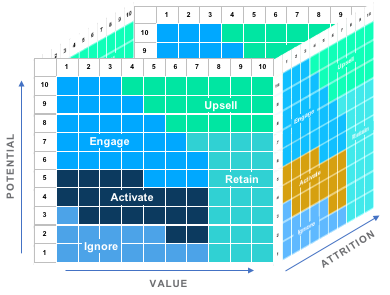Not every company has a loyalty program, and not every company has a loyalty team. But right now, every company is evaluating how to build loyalty in a contactless world.
Contactless experiences aren’t new—they’ve simply been accelerated due to COVID-19.
Data emerging from the past few months is telling. According to Mastercard, 79% of people around the world are currently using contactless payments, and 74% will continue to use mobile payments after the pandemic subsides. In early April, Adobe Analytics recorded a 208% YOY increase in online-to-in-store pickup. And an Epsilon survey found that two-thirds of consumers feel there will be permanent changes to daily life due to the pandemic.
How do brands adapt to these shifting behaviors and create contactless experiences that matter? There are four essential building blocks for a successful contactless loyalty program that will resonate with customers.
1. Reassess the value exchange you have with customers
The relationship between the brand and the customer is built on a two-way value exchange that meets customers’ rational and emotional needs. A customer that likes your brand might open your emails, but a customer that loves your brand will drive the extra seven miles to the next exit where your hotel is located.

Forrester’s Emily Collins echoed similar sentiments in a recent report. “It’s natural to want to jump in with a specific use case or channel, but laying out the existing loyal customer journey grounds you in the customer’s state, rather than your short-term business objectives,” she said.
In a world that is socially distanced, the question now becomes: What value is your brand actually creating in a contactless environment that will still elicit those feelings of love? Can you deliver real-time rewards and experiences that build long-term loyalty, and factor in the new expectations that consumers have?
Marriott is a great example of a brand that shifted to add real value this year through contactless engagements in their Marriott Bonvoy app.
For example, after 4 p.m., travelers receive a push notification to check-in and another notification when their room is ready. And they can then unlock their room from their phone, watch or Siri with Mobile Key Shortcuts. Plus, at the conclusion of their stay, guests can check out through their phone and have their receipt emailed, again allowing them to skip the front desk and keep a safe distance from other travelers.
These updates appeal to both the rational and emotional side of the loyalty equation because they provide easier access to entry and checkout and they ease anxiety for travelers. This provides a true value-add to customers while also encouraging loyalty app downloads and use.
2. Invest in the right tools to keep your strategy nimble
If 2020 has shown us anything, it’s that flexibility is key for all marketing initiatives. Ask yourself how flexible your programs and partners are. How quickly can you pivot to new tactics and strategies and what’s the uptime to actual implementation?
At Epsilon, we focus on three main tenets for staying flexible while planning ahead.
Predict: A good loyalty strategy requires investment, which means you need to prove that to your CFO and executive board. The business needs to recognize that loyalty is not about giving discounts, it’s about growing engagement and bottom-line results over time. With that in mind, Epsilon works with clients to build five-year ROI plans that show what investment produces what returns so they can track toward real, measurable outcomes with their stakeholders.
Pace: Planning and setting goals are an important first step, but gone are the days of executing a strategy and analyzing once it has finished. Epsilon works with clients to plan rational and emotional goals and plus track progress along the way. It’s critical to understand real-time results so you can pivot to achieve your goals.
Pivot: Being able to pivot—quickly—is key to making this work. There is no value in setting a three to five-year plan and never looking at it again. Things change, the business changes, the world changes. Your loyalty strategy needs to be flexible to meet those needs, and you need the right tools to act on it.
3. Use loyalty data as your secret weapon
Knowing your customers—across all of their interactions with your brand—is critical to building loyalty. Identity-based profiles can connect online and offline interactions to digital and physical experiences so that marketers can understand the breadth of a person’s engagement with their brand.
This holistic customer view helps shape investment in each individual immediately and over time. We help clients do value and attrition analyses to know who in their customer universe is extremely loyal versus those that are in their loyalty program but have less potential for ongoing engagement.

For example, if a customer is high-risk for attrition, it’s okay to not serve them new rewards or new exclusive offers. But if that person is at medium-risk for attrition, then you can include them in a win-back campaign to lower their potential for attrition and turn them back toward your brand.
4. Loyalty cannot be an island
Loyalty is not a standalone initiative—it’s the goal of every interaction a customer has with your brand. At Epsilon we often talk about building enculturated loyalty, meaning that loyalty is a part of every facet of the business, not just a marketing or customer retention initiative.
Since 2013, Epsilon has worked with Dunkin Brands to architect and build their DD Perks program, which now has more than 12 million members. DD Perks set the bar for many other brands exploring loyalty initiatives, and their cross-business loyalty focus has been crucial in our new contactless world. Dunkin shifted early on in the pandemic to offer safe, contactless ordering and pickup through their app. And their strategy goes beyond a quick fix for the pandemic to ensuring support for longer-term goals and revenue. Here’s a look at how that’s done:
- Focus on app downloads: Dunkin’s external messaging promotes the app as the first step in the ordering process. Once customers have downloaded the app, they can choose to continue signing up for the rewards program or order as a guest.
- Keep benefits front-and-center: Dunkin offers step-by-step guidelines for ordering digitally—from downloading the app to picking up an order—with articles and videos discussing how safe and easy the process is. This shows benefits up front, reinforcing why customers should use the app to place orders.
- Connect digital and physical experiences: Dunkin added curbside pickup to 1,000 stores that didn’t have drive-thru options, and that now represents 2% of all transactions at those stores. They also expanded delivery from 2,000 to 4,000 locations across the country, and contactless delivery orders are 3x the average check size.
They also allow members to save their favorites for easy reordering—ensuring customers can have their favorite coffee and a meal in hand quickly.
Brands can build loyalty in a contactless world—and hopefully contactless won’t be a requirement due to a pandemic, but instead a continuing evolution of loyalty needs and technology.
**This post is an update to an article originally posted on Adweek, October 2020.
